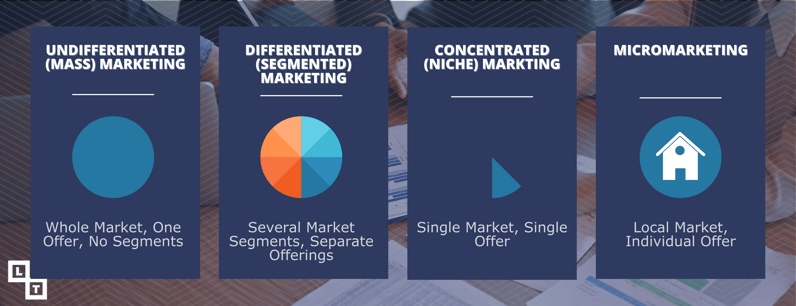We are taking a break from the regularly scheduled blog content on the LT Blog and offering something a little different to a new target market of emerging, nascent marketers. Typically we take a deep dive into the industries in which we work, with our content ranging from insightful Marketing Insights: LaneTerralever Imparts Their Thoughts on Super Bowl LVII Ads to discussing strategic Economic Indicators and Guidance for Marketing in a Difficult Economy if that interests you, great! Please feel free to check that out. If you are here for some fundamental basics of marketing, this page is designed for either first-year marketing undergraduates who are bogged down by their general education course load and counting down the semesters until they take their first marketing class or for those undecided college students who are researching which major they want to spend the rest of their lives on.
This blog is a creative capstone project for Arizona State University’s Services Marketing Strategy course and will contain a complete definition of marketing, one official, lengthy definition, and one that you may find more palatable to keep in your arsenal of marketing knowledge. The three marketing strategies—segmentation, targeting, and positioning—will be differentiated and given applicable examples. Lastly, we will introduce you to the vivacious debate in the marketing realm surrounding whether there are four or seven marketing tactics—some really comically thrilling stuff!
Definition of Marketing
Suppose you are in marketing or even thinking about a career in marketing. In that case, you may want to familiarize yourself with AMA's definition of marketing. It will pop up in your first marketing course and seemingly all other marketing courses to follow. Still, I may be getting ahead of myself. When I first started college, acronyms like this flew through one ear and out the other. If you ask Google, AMA is the American Medical Association; However, if you read a definition of marketing from an entity named AMA, it is the American Marketing Association. AMA has over 250 collegiate chapters across the United States. Not to sound like any residential assistant, community assistant, or parental guardian—ever—but look into getting involved in applicable advertising, marketing, or business-related clubs on your campus if you want to build upon this existing marketing knowledge.

Funny—how that definition alludes that marketing is an activity, a noun, and a verb. Marketing is a blend of scientific acuity and imaginative expression, harmoniously woven to captivate and engage audiences while guiding them toward desired outcomes based on strategic insights for applicable stakeholders. The science encompasses data-driven decision-making, precise targeting, and strategic planning from market research and understanding consumer behavior psychology to achieve measurable results. At the same time, the artistry lies in crafting compelling narratives, designing visually stunning experiences, and eliciting emotional responses. There is a reason you could go to one university and get a Bachelor of Science (BS) in Marketing or attend a neighboring university just one city away to earn a Bachelor of Arts (BA) in Marketing or marketing-related degrees such as Global Business Marketing, Digital, and Integrated Marketing Communications. Several universities allow the student to choose between a BS or a BA in Business, Psychology, and Marketing—to name a few.
Branding can be easily understood as a form of marketing by simply looking at your T-shirt, pants, or shoes. Do you notice a name, term, design, symbol, or other distinctive feature that sets the shirt apart from other sellers? It could be a swoosh, three stripes, or perhaps a certain cat indigenous to the mountains of North and South America. Unless you are wearing a plain, generic article of clothing, you are marketing a brand. So, exactly what can be marketed?
Marketing Strategy
Marketing involves three primary strategic approaches that guide the planning and execution of promotional activities of a product or service—segmentation, targeting, and positioning. Marketing strategy encompasses the broader, long-term plan or approach that outlines an endeavor's overall direction and goals. It involves making decisions about allocating company resources, defining objectives for your final destination, and determining the most effective way to achieve those marketing objectives. The strategy sets the framework for decision-making and guides how to achieve a desired outcome.
Segmentation
Segmentation involves the process of grouping or categorizing buyers based on shared segmentation variables or mutual needs. Segmentation variables are characteristics of whom you are segmenting and are used to divide a market of potential buyers into comprehensible slices for marketing professionals to tailor offerings to comfortably. These variables include demographics, geographic, psychographic, and behavioral factors. From these variables, segmentation profiles and personas can be created to outline procedures to identify the segments and act as a brief description of those segments.

1. Demographic Variables
Demographic variables are used in market segmentation and research to categorize and understand populations based on specific, quantifiable characteristics such as age, gender, race, ethnicity, household income, level of education, occupation status, household size, family life cycle stage, marital status, religion, political affiliation, or social class. Demographic variables are widely used in marketing and market research due to their ease of measurement. Most notably, they can be found in the classification question section at the end of an extra credit survey where it asks, "What is your age?" "What is your gender?" and "What is your annual household income?"
2. Geographic Variables
Segmenting based on location-based geographic variables involves considering regional factors such as population type (urban, suburban, or rural areas), location (country, state, city, or ZIP code), population density, climate, season, terrain, and cultural preferences. This is important because different geographic locations often have distinct market conditions, such as varying competitive landscapes, regulatory environments, and economic factors that can significantly impact marketing strategies, messages, promotions, or product offerings. Geographic variables help to establish a stronger connection with consumers in those locations to enhance the relevance and effectiveness of marketing efforts. What location-based, geographic variables did Hulu, the streaming platform, need to know for this advertising campaign?
For Hulu's 15th anniversary, the company rented a boat and placed banners on it. It seems like a simple concept, but it would not have been successful if Hulu had not leveraged geographic variables and the tradition-related psychographic variable. In order to ensure the success of this campaign, Hulu had to be aware of the iconic seasonal tradition in the city of Chicago, where the Chicago River is dyed vibrant "Hulu green" on the Saturday before each St. Patrick's Day. For this non-traditional out-of-home, place advertising campaign to be effective in terms of exposure, relevant geographic variables, such as an urban population with high population density, were considered by Hulu.
3. Psychographic Variables
By using psychographic variables, marketers can better understand consumer motivations, preferences, and behaviors and tailor their marketing strategies and messaging to resonate with specific psychographic segments of their target audience. Differentiating marketing by personality, attributes, motives, lifestyles, interests, and hobbies can lead to more effective and personalized marketing campaigns, increased customer engagement, and improved business outcomes. Research in psychology shows that the Big Five personality traits have biological bases as they are observable in cultures worldwide; these personality traits include openness, conscientiousness, extroversion, agreeableness, and neuroticism (OCEAN)—which you may learn in your first introduction to psychology course.
4. Behavioristic Variables
Behavioristic variables are a set of characteristics or factors used in consumer behavior analysis to understand and categorize individuals based on their observable behaviors, actions, and responses concerning products, services, or brands through market research techniques. Some behavioristic variables include volume usage rate (heavy users, moderate users, light users, or non-users), usage occasion, end user (who uses the product or service), benefit expectations, brand loyalty, price sensitivity, and a consumer's readiness to buy.
Targeting
A target audience, also known as a target market or target segment, refers to a specific group of consumers or individuals to which a business or organization aims to reach, engage, and sell its products, services, or messages. Targeting typically occurs after the consumers have already been identified and grouped—whether that grouping is broad or narrow. While segmenting is about identifying a group of customers in your market who share similar needs and wants, targeting is about choosing a group of customers to market using the following four targeting strategies:
If you are or have been a college student or have explored the possibility of attending college, you have likely encountered these various targeting strategies. Undifferentiated marketing, or mass marketing, involves broadcasting a message to reach the broadest possible audience. In this case, universities lease billboard space along highways without being able to target who will see it precisely but with the expectation that it will be visible to a general audience. Universities tailor their email marketing communications through differentiated marketing to prospective students based on their declared or prospective major. Many universities emphasize how their business programs can meet the unique needs of a niche audience of high school students who have expressed an interest in marketing through concentrated marketing campaigns. Micromarketing occurs at an individual level. If you take a moment to observe your surroundings, you may notice examples of marketing efforts that are specifically for you—perhaps check your social media.
Positioning
Positioning refers to establishing and maintaining a specific perception of a product, service, or brand in customers' minds. It involves carefully crafting the market offering's image and reputation among the intended audience. The goal is to shape how customers perceive and differentiate the brand from competitors, ultimately creating value for the targeted customers. Marketing authors Philip Kotler and Kevin Lane Keller define brand positioning as:
Positioning ultimately resides in the mind of the consumer, but marketers can influence it by aligning brand elements, also known as brand identities, with the values of the target consumers. Proper positioning of a brand enables it to connect with consumers, resulting in brand satisfaction, brand loyalty, emotional attachment, and a sense of community among its customers. Patagonia, Trader Joe's, and Harley-Davidson are notable examples of brands that have successfully established their own distinct value, messaging, visuals, and identity, setting them apart from others in the market.
Marketing Tactics
Marketing strategy involves segmenting the overall market into smaller groups based on shared wants and needs, selecting the segment or segments to target, and differentiating the market offering to create superior customer value in the minds of target customers. On the other hand, marketing tactics are the specific actions or techniques employed to execute the strategy and achieve short-term objectives. The marketing mix, colloquially known as the Four P’s of Marketing or the Seven P’s of Marketing in the context of services, is a foundational model that depicts the set of marketing tools the brand uses to pursue its marketing objectives. The Four P's of Marketing consists of product, price, place, and promotion, while the Seven P's of Marketing include the additional elements of physical evidence, process, and people.
Product
Product is more than just the features of the physical goods, and it includes the level of quality, accompanying accessories, types of warranties, product lines, branding, product-support services (customer service helplines or maintenance repairs), and even packaging. Packaging communicates the overall brand's value proposition. From the perspective of both the firm and consumers, packaging must achieve a number of objectives, such as enabling consumers to identify and differentiate the brand from others, conveying descriptive and persuasive information, facilitating safe product transportation, assisting in at-home storage, and aiding in the product's consumption.
Selena Gomez's makeup company, Rare Beauty, offers a relevant illustration of product packaging that goes above and beyond surface-level aesthetics and that holds a deeper meaning. While the Rare Beauty packaging was not specifically designed for people with dexterity challenges, the product was designed to Selena's personal preferences to emphasize ease of use as she was diagnosed with lupus—a common symptom being muscle and joint pain. Ease of use and inclusivity are highly prioritized at Rare Beauty, evident even in the thoughtful design of its packaging, no matter how small the details may seem.
Price
Following a similar sentiment, price is more than just money. I could list the never-ending pricing strategies (demand-based pricing vs. competition-based pricing) that business professionals leverage when determining a product or service's return on investment; However, elements such as flexibility, terms, differentiation, discounts, allowances, and price point levels all play a role. Pricing communicates the level of accessibility for differing segments. Inconsistent price points lead to the weakening of favorable associations or the addition of negative ones due to brand-related activities; brand dilution. The presence of inconsistent pricing, something as seemingly simple as that, can result in numerous negative impacts on a brand—most noteworthy, confusion about the brand's positioning. Would Waffle House still feel like a Waffle Home without its hallmark of affordability and catering to late-night and sunrise cravings?
Place
Marketers love their alterations: Krispy Kreme, Dunkin' Donuts, Coca-Cola, marketing mix, product, price, place, promotion, physical evidence, process, and people. While place includes servicescapes such as physical outlet locations, it primarily refers to distribution principles and terminology—so here is a little introduction to logistics. In the buy it, make it, and move it of supply chain management, distribution facilitates the movement of goods downstream—toward the end consumer—and upstream—back to the supplier through reverse logistics. Place is how a product reaches the end consumer and encompasses exposure, intermediaries, transportation, storage, channel type(s), and managing channels. The direct channel type entails a direct transaction between the producer and the customer, such as purchasing Levi's from an outlet store. On the other hand, the indirect channel type involves an intermediary, such as buying Levi's from Target.
Promotion
Promotion involves a wide range of integrated marketing communication tools, including advertising, sales promotion, event marketing, public relations, and personal selling. While exposure is categorized in the marketing mix as place, marketers select the vehicle for exposure in the form of advertisements. Native advertising is a favored form of promotion by many marketers due to its seamless integration into the surrounding content or platform, making it less disruptive and more engaging for the audience. While the Super Bowl may mean nothing to you now, as a marketing major, you will become acutely acquainted with Super Bowl ads—every single year, after year, after year. Tubi, an American streaming service, used native advertising to convincingly make it seem like someone was changing the channel during the game in their Super Bowl 2023 commercial resulting in positive word of mouth (WOM).
Physical Evidence
The first introduction to the concept of physical evidence stemmed from my Introduction to Human Communication course, where we discussed the importance of trappings regarding authority—a weapon of social influence where we feel a strong pressure to comply with the requests of an authority figure. Trappings are tangibles (or physical evidence) that convey a message through the environment in which the service is delivered and where the firm and customer interact. It can include the facility's design, equipment, signage, employee uniform, website pages, business cards, and more. The role of the servicescape is to portray an image, act as a point of difference between one brand and another, facilitate accomplishing goals, and signal socialization roles between employees and customers. When physical evidence is misaligned, consumers' perceptions of the brand may falter or change. Have you ever walked into a retail store and not known who works there as you looked around and noticed that the employees are wearing regular, everyday T-shirts? Well, that deals with physical evidence.
Process
The process is the steps for delivery, the number of steps, whether simple or complex, is the product or service standardized and can be made on a conveyor belt, or is there customization to it that the employee will be trained on? Is the customer involved in the process, or should the customer remain hands-off? The process consists of procedures, mechanisms, and flow of activities by which the service is delivered, consumed, and co-created—the service delivery and operating systems.
Southwest Airlines distinguishes itself from other airlines by employing a unique boarding process. Although you still purchase a ticket and receive a number, Southwest does not assign a specific seat. Instead, you join the boarding process line, and when you enter the airplane, you have the freedom to choose your seating—whether you prefer to be seated in the front alongside the wheelchairs or at the back near families with newborns, the choice is yours. Take Starbucks as another example; they sell and advertise standardized offerings such as the caramel cloud macchiato or the infamous autumn pumpkin spice latte (PSL); However, whether you walk up to a barista at the counter or order on the app, the customer can customize their drink—now with additional fees. Baristas consider the customization options as they craft beverages to fulfill specific orders, which may involve varying steps or complexities. This ensures that drinks are tailored to individual preferences, whether simple or elaborate orders with numerous specifications, and Starbucks explicitly markets its made-to-order modifications.
People
The final component of the services marketing mix is the people. People-related factors encompass customers and employees and considerations such as customer education and training. Employees relate to recruitment, training, motivation, and reward systems (such as seniority vs. skill). This holistic approach acknowledges the significance of people in shaping the service experience from both the customer and employee perspectives, as all human actors who play a part in service delivery influence the buyer's perception—even the buyer themselves. Whether you are aware of it or not, you have been trained to be an ideal customer. Ironically, many grocery stores have adopted scan-and-go apps or self-scan checkout kiosks and have found success by gradually training their customers over time. It is reminiscent of the plastic Fisher-Price cash register that many of us may have played with as kids, which helped us learn about handling money and making transactions. It's not to say that it's some grand conspiracy by Big Grocery Store to indoctrinate our toddlers into using self-checkout, but rather, how kids are given toys that resemble everyday objects (toy vacuums, toy lawnmowers, or even toy vegetables) to introduce them to the concept in a fun and familiar way. It's a charming reminder of how these stores have creatively influenced our shopping behaviors through subtle cues, nostalgic connections, and attentive responsiveness to their conditioned customers.

.png)



